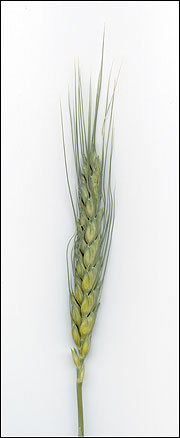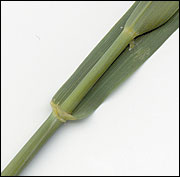Small grains
Cool-season grasses
The small grains, primarily wheat and rye, are used extensively in Kansas, Nebraska, Oklahoma and Texas for winter pasture for stocker calves, but they can fit into pasture systems in Missouri as well. If planted around Sept. 1, wheat or rye will produce enough forage for an initial grazing by late November under normal conditions. Wheat and rye continue to grow through the winter, although they grow slowly during cold spells. Rye generally produces 30 to 60 percent more forage than wheat. In a vegetative state, small grain pasture is often more than 20 percent crude protein and 23 to 28 percent acid detergent fiber. Wheat and rye remain in a vegetative state until mid- to late March; as a result, forage quality is fairly constant from November through late February. Rye matures three to four weeks earlier than wheat and thus is hard to manage for high-quality feed after March. In addition, small grain pasture is susceptible to trampling damage under muddy conditions.
 Wheat
Wheat
 Yield distribution of small grains in Missouri.
Yield distribution of small grains in Missouri.
- Origin: Near East and Europe
- Adaptation to Missouri: Statewide
- Cereal rye (Secale cereale L.)
- Blade: Leaf bud rolled, about 12 veins, twisted clockwise, pubescent, not shiny green on lower surface.
- Sheath: Open, pubescent (slight to very hairy).
- Ligule: Short, membranous.
- Auricles: Very short.
- Seed head: There is one spikelet at each rachis node and two fertile florets in each spikelet.
- Oat (Avena sativa L.)
- Blade: Leaf bud rolled. Glabrous with about 12 veins, twisted counter-clockwise.
- Sheath: Open, usually glabrous.
- Ligule: Long, acute, toothed, membranous.
- Auricles: Absent.
- Seed head: Open panicle with a single spikelet on each rachis branch.
- Wheat (Triticum aestivum L.)
- Blade: Leaf bud rolled. about 12 veins, twisted clockwise, pubescent (slight to very hairy).
- Sheath: Open, pubescent (slight to very hairy).
- Ligule: Membranous.
- Auricles: Short with blunt tips and pubescent.
- Seed head: Single spikelet at each rachis node. Three to five florets per spikelet.
- Fertilization: 75 lb N/ acre at establishment. An additional 40 to 60 lb N/ acre can be applied in late February if needed. Phosphorus and potassium to soil test.
- Timing of production: 70 percent of growth from Feb. 1 to May 1.
- When to begin grazing: When the grass reaches 8 inches in height.
- When to cut for hay: Boot stage, typically in late April or early May.
- Lowest cutting or grazing height: 4 inches
- Fall management: Grazing possible in late fall if a 4-inch stubble is maintained throughout winter.

